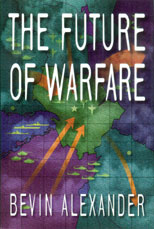 Click here to purchase from Barnes & Noble.
Click here to purchase from Amazon.com.
Click here to purchase from Barnes & Noble.
Click here to purchase from Amazon.com.
Tactics of the Chinese Communists in the Korean War
Excerpt from The Future of Warfare, by Bevin Alexander, 150-52
The first job of Chinese Communist forces when they invaded North Korea [in autumn 1950] was to stop the United Nations advance, which was nearing the Yalu River.
Although extremely limiting in some respects, the Chinese dependence upon the backs of animals and soldiers liberated them from roads and permitted troops to fight anywhere they could walk, whether in front, on the side, or behind the enemy lines. UN forces, on the other hand, were tied to the roads because their supplies arrived by truck. The roads, therefore, were vulnerable to being cut by roadblocks.
During the Chinese civil war, Mao Zedong and his commanders had developed a highly effective method of dealing with more heavily armed Nationalist troops. Peng Dehuai now adapted these tactics to the Americans and their allies.
The Chinese tried whenever possible to infiltrate through enemy positions in order to plant a roadblock on the supply line, in hopes of inducing the enemy to retreat to regain contact with the rear. If UN forces stayed in position, the roadblocks still were useful in cutting off escape routes and supply.
In infiltration and assaults against front-line positions, the Chinese moved largely at night to avoid air strikes and reduce aerial observation. In attacks they tried to isolate individual outposts, usually platoons, by striking at the fronts, while at the same time attempting to outflank them. The purpose was to defeat forces in detail by gaining local superiority. If they could not destroy enemy positions, they hoped to induce the opponent to withdraw. When this failed, they got as close as possible to the enemy so that, when daylight came, U.S. aircraft would be unable to bomb them for fear of hitting friendly troops.
Advancing Chinese units generally followed the easiest, most accessible terrain in making their approaches: valleys, draws, or streambeds. As soon as they met resistance, they deployed, peeling off selected small units to engage the opposition. However, if they met no resistance, the whole column often moved in the darkness right past defensive emplacements deep into the rear of enemy positions. There were many examples of this in Korea. In some cases entire Chinese regiments marched in column formation into the UN rear.
Once fully committed, the Chinese seldom halted their attack, even when suffering heavy casualties. Other Chinese came forward to take the place of those killed or wounded. The buildup continued, often on several sides of the position, until they made a penetration ---either by destroying the position or forcing the defenders to withdraw. After consolidating the new conquest, the Chinese then crept forward against the open flank of the next platoon position. This combination of stealth and boldness, usually executed in darkness against small units, could result in several penetrations of a battalion front and could be devastating.
Since the Chinese tried to cut the defending force into small fractions and attack these fractions with local superiority in numbers, they favored the ambush over all other tactical methods. As a rule attacking Chinese forces ranged in size from a platoon to a company (50 to 200 men) and were built up continually as casualties occurred.
The best defense was for the UN force somehow to hold its position until daybreak. With visibility restored, aircraft could attack the Chinese and usually restore the situation. However, Chinese night attacks were so effective that the counsel often went unheeded and defending forces were overrun or destroyed.
<< More 'Korean War' Excerpts << Back to top>